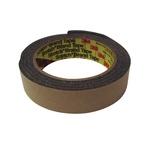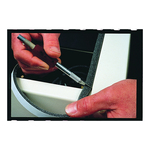3M™ 7010373381 Single Coated Open Cell Tape, 18 yd L x 2 in W, 250 mil THK, Acrylic Adhesive, Urethane Foam Backing, Charcoal Gray
Price$104.44
Item #MSD67473
Brand3M™
Manufacturer3M™
Mfr. Model #7010373381
Country of OriginUS
UNSPSC Code31201527
UnitEA
Sold in Packs of6
DGI AvailabilityCall for Availability
| Standards & Approvals |
|---|
| ASTM D3574 |
| ASTM D2240 |
| ASTM D1667 |
Product Features
• Excellent cushioning characteristics and high absorbency
• Dampens sounds and absorbs vibration when used in electronic applications
• Offers high initial quick stick to multiple substrates
• Provides excellent shear strength and high temperature performance
• Compressible interior sealing applications
• Clean appearance
• Seals out moisture, dust and drafts
• Charcoal gray, 0.250 in (6.4 mm) soft conformable, low-density, open-cell foam design helps seal out air, dust and light when compressed
Description
3M™, 7010373381, Tape, Single Coated Open Cell, 18 yd Length, 2 in Width, 250 mil Thickness, Charcoal Gray, Acrylic Adhesive, Urethane Foam Backing, 25 psi Tensile Strength, 2 cu-ft/lb Foam, 302 deg F Maximum Operating, -20 deg F Minimum Operating, Specifications Met: ASTM D3574/D2240/D1667
3M™ urethane foam tape 4314 is a conformable, low-density, open cell foam tape with a pressure sensitive acrylic adhesive on one side. This tape will adhere to a variety of substrates and can be used in numerous mounting applications to dampen sound and create a clean and durable product. 3M™ urethane foam tape 4314 is 1/4 in THK, comprised of a soft conformable, low-density, open cell foam with a pressure sensitive acrylic adhesive on one side. The adhesive is protected by a silicone treated paper liner. It offers excellent cushioning characteristics while providing high absorbency to seal out moisture, dust and drafts. It can perform under a wide range of temperatures. Special note - extra care should be taken when handling to avoid damaging tape. 3M™ urethane foam tape 4314 features 3M™ adhesive 430. This pressure sensitive, modified acrylic adhesive provides high initial quick stick to a variety of surfaces and substrates. It has an excellent chemical resistant and shear holding strength, even at elevated temperatures. Adhesive 430 is designed to perform at temperatures up to 180 deg F (82 deg C) in the short term and 150 deg F (70 deg C) long term. The adhesion of 3M™ single-coated foam tapes is typically satisfactory within 20 min and continues to build with additional time. The adhesive is protected by a thick, silicone treated paper liner and has a firm, high density foam. This design offers an attractive and clean appearance after application. Open cell foams are commonly used between component panels where a degree of separation is needed to dampen or prevent vibration, as a thermal insulation barrier and to protect against contamination, but where a measure of airflow is still necessary, such as with electronic components where air flow helps keeps components cool.




